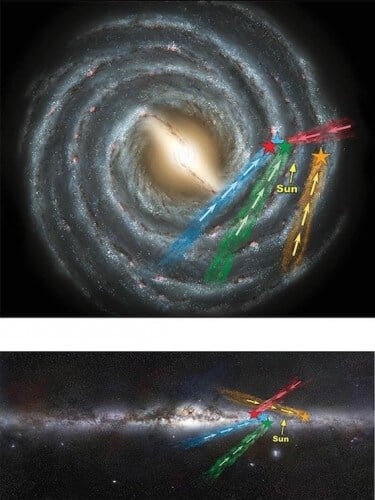Unlike the stars that left the galaxy and were observed so far, which were large and came from the center of the galaxy, this time it is about stars the size of the sun that come out from different places in the galaxy

An international team of astronomers discovered a new type of extremely fast stars "hypervelocity stars" - individual stars that have developed enough speed to escape the gravitational grip of the Milky Way galaxy.
The discovery was revealed at the annual meeting of the American Astronomical Society that gathered last week in Washington. The discovery was published in the January 1 issue of the Astrophysical Journal.
"These fast stars are very different from those discovered so far," says Lauren Palladino, a doctoral student at Vanderbilt University and the lead researcher on the study. "The original fast stars were large blue stars and appear to have originated in the center of the galaxy. The new stars are relatively small - about the size of the Sun - and the surprising part is that none of them have left the galaxy's core."
These stars were discovered when Palladino, under the supervision of Kelly Holly Buckelman, professor of astronomy at Vanderbilt, mapped the Milky Way by calculating the orbits of sun-like stars imaged by the Sloan Digital Sky Scanner. Sloan surveyed a vast area of stars and galaxies covering about a quarter of the sky.
"It's very difficult to kick a star out of the galaxy," says Holly-Bockelman. "The most common mechanism for this is related to the black hole at the center of the galaxy. However, none of these fast stars came from the center, which indicates a new and surprising type of fast stars, which have a different ejection mechanism."
The astrophysicists calculated that a star should receive a boost at a speed of over one and a half million km/h relative to the movement of the galaxy in order to reach escape velocity. They also estimate that the mass of the black hole at the center of the galaxy is roughly equal to 4 million suns. This is a large enough mass to produce a gravitational force strong enough to accelerate the stars to super velocities. The typical scenario involves a pair of stars (a double star) large enough to produce a strong enough gravitational force to accelerate the stars to escape velocities. As one of the stars spirals towards the black hole, its companion is pushed outward at enormous speed. So far, 18 fast stars have been discovered that could go out thanks to this mechanism.
More of the topic in Hayadan:
- Hubble photographed a star that the black hole kicked out of the galaxy
Escaping stars may explain the mystery of medium-sized black holes
Now Palladino and her colleagues have discovered another 20 stars that are similar to the Sun and have the characteristics of fast stars. One of the concerns is that there was an error in measuring the movement of the stars. According to her, "to measure the speed of a star, its position must be measured with great precision over large time intervals. It may appear as if it is moving faster than its actual speed. We did some statistical tests to increase the accuracy of our estimates. Therefore, we believe that even if some of these candidates turn out to be wrong, most of them are real."
The astronomers will now make follow-up observations. "These stars are similar in their composition to ordinary stars in the disk of the galaxy, so there is no reason to think that they originate from the bulge of the center of the galaxy, the halo surrounding it or in exotic regions outside the galaxy. The big question is what accelerates these stars to such speeds? This is what we want to find out now," says Holly Bokelman.

4 תגובות
Hello my father!
The article is really unclear.
If the velocities are created due to the huge amount of mass in the black hole, then the stars should move (be pulled) towards the black hole with increasing acceleration, and the velocity increases anyway.
From the article I understand that the stars move in the exact opposite direction to the position of the black hole.
The next sentence is really unclear "a star needs to be boosted at a speed of over one and a half million km/h relative to the movement of the galaxy in order to reach escape velocity" Why don't you specify the amount of force applied and who applies it? (And I may be missing something in understanding Newton's laws).
incidentally,
I have an answer regarding stars escaping from galaxies:
If you look at a number of spiral galaxies,
You will argue to know that on the "arms" of the galaxies,
There are bifurcations of the arms, which is typical of an eruption from an explosion.
These explosions are a source of tremendous energy that is thrown
material in different directions.
Most of the movement continues in the vector in the direction of the movement of the arm (outwards).
This is the source of energy that causes stars to escape from the galaxy...
This is in accordance with the original theory of Hezi Atzil, which explains the formation of galaxies.
skeptic
"On the other hand" ... don't you have a second side??
What is strange about space exploration,
Until now we don't know how stars are formed,
According to the accepted big bang theory...